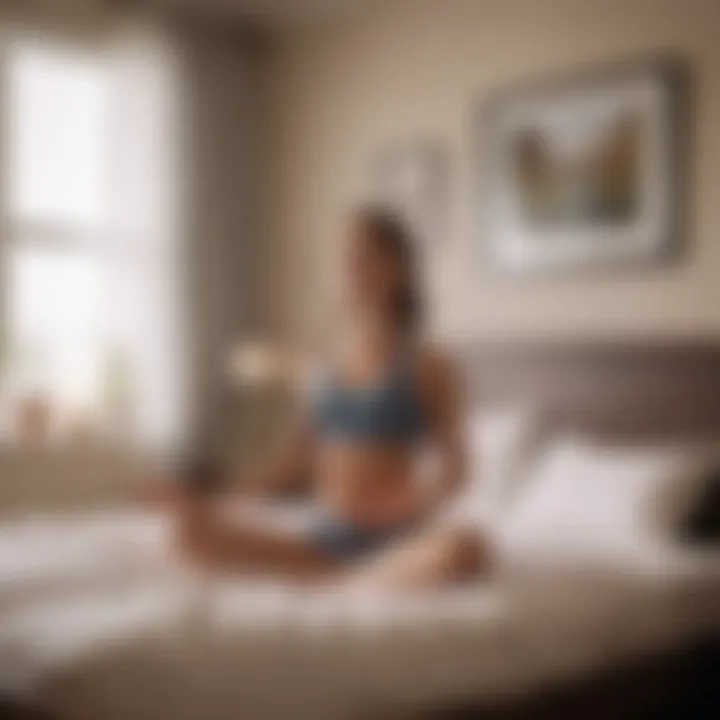Explore the Benefits of 5-Minute Bed Yoga


Intro
In our fast-paced world, finding time for self-care can feel as elusive as the morning sun behind the clouds. Yet, an often-overlooked approach to incorporate wellness into our daily routine is through 5-minute bed yoga. This practice melds the comfort of your bed with gentle stretching and mindfulness, laying the groundwork for a day filled with clarity or providing a relaxing transition to a restful night.
Imagine waking up, stretching your arms above your head, or gently doing a seated forward bend, all without the need to step off the mattress. This simple routine can foster both physical and mental well-being, catering to novices or seasoned yogis alike. Particularly for those juggling busy schedules, this minute investment in yourself can yield profound benefits.
"Incorporating a few moments of mindful activity, even when tucked in your sheets, can act as a bridge to a more harmonious life."
As we delve deeper, this article will explore various yoga poses designed for the bed and their incredibly unique benefits, all while aligning with a holistic approach to wellness. Regardless of your flexibility or experience level, bed yoga can transform moments of stillness into opportunities for growth and rejuvenation.
Understanding Bed Yoga
When we think of yoga, the image that often comes to mind is one of bending, stretching, and assuming pretzel-like positions on a mat, perhaps in a serene studio environment. However, bed yoga offers a fresh perspective that blends comfort with wellness, redefining how and where we practice. This concept prioritizes personal space, allowing individuals to engage in yoga routines right from the coziness of their own bed. As we delve into this fascinating practice, it becomes clear that understanding bed yoga is essential for anyone looking to improve both mental and physical health without the constraints of time or location.
Definition of Bed Yoga
To put it simply, bed yoga refers to a collection of stretching and relaxation exercises executed while lying in or sitting on your bed. It is designed to ease the body into the day or gently wind down before sleep. The beauty of this practice lies not only in its accessibility but also in its adaptability—everyone, from the least flexible to seasoned yogis, can incorporate it into their routine. Essentially, it’s about harnessing the power of restorative movements in an environment that feels secure and inviting.
Origins and Evolution
The concept of integrating yoga with rest isn’t brand new. It draws from ancient traditions where practices are naturally aligned with an individual’s environment. In recent years, though, the global hustle and bustle has seen an increase in stress levels among individuals. This pushed for a need to adapt yoga to fit our contemporary lifestyles, and thus, bed yoga has seen a rise in popularity. While traditional yoga prepares the body and mind for more rigorous activities, bed yoga focuses on gentle movements that cater to relaxation and self-care—important aspects often overshadowed in a fast-paced world.
Why Choose Bed Yoga?
Bed yoga offers numerous advantages, making it an appealing choice for many:
- Convenience: You don’t have to change clothes or go to a studio. You can simply roll out of sleep and into your practice.
- Comfortable Environment: The bed provides a softer surface, making it easier on the joints, especially beneficial for those with mobility concerns or chronic pain.
- Brief and Effective: Even just five minutes of targeted movements can significantly enhance flexibility and relaxation, which can lead to improved sleep and reduced tension throughout the day.
- Lowered Entry Barriers: For those new to yoga or hesitant about attending classes, the casual setting can make the practice feel less intimidating, fostering a more inviting atmosphere.
"Yoga is not just a workout; it's a work-in. And what better place to start than where you feel most at ease?"
Engaging in bed yoga encourages individuals to reclaim their mornings and evenings—to cultivate mindfulness amid the often chaotic routines of modern life. By intertwining movement with a sense of coziness, bed yoga empowers practitioners to take those first important steps on their wellness journey without even leaving their sheets.
The Importance of a Morning Routine
Mornings set the stage for the day ahead. A thoughtfully crafted morning routine, even if it's merely 5 minutes of bed yoga, can work wonders for one’s overall well-being. It may sound remarkable, but integrating these brief moments into your morning can reshape how you engage with your day. Let's delve into why this morning ritual deserves a spot in your life.
Enhancing Mental Clarity
Starting the day without a clear mind is like trying to drive a car with foggy windshields. A few minutes of yoga can clear away the morning haze, sharpening both focus and concentration. When you practice simple poses while still in bed, you stimulate blood flow and awaken your senses.
Research indicates that physical activity in the morning can significantly boost alertness and cognitive function. A gentle stretch here and there might seem trivial, yet it’s about shaking off the grogginess, bringing mental clarity into focus. This mental uplift can help you tackle your to-do lists with a level head.
Setting a Positive Tone for the Day
It’s easy to let the world hit you right in the face as soon as you wake up. However, establishing a morning routine gives you the control you need to set a positive tone. When you take a moment for yourself, it’s like putting on your favorite song before a party – it just feels good.
By starting your day with intention, you create a sense of empowerment. Techniques such as taking a few deep breaths during your bed yoga practice can calm the mind. You may instill an attitude of gratitude. Focusing on aspects of life you appreciate – be it family, simple comforts, or personal goals – this sets an uplifting mood that lingers throughout your day. When you enter the world on your terms, the chances are higher that you’ll bask in a day that’s productive rather than reactive.
Physical Benefits
Making space for even a tiny morning exercise routine like bed yoga does wonders for the body. Stretching stiff muscles not only helps increase flexibility but also gets the blood pumping, which in turn can energize your system. You might not be aiming for Olympic levels of flexibility, but just simple movements can alleviate tension that all too often builds up overnight.
As each muscle group receives attention, you'll start to notice a decrease in aches and pains. Stretching the back, shoulders, and legs in particular can be a game changer for overall comfort and mobility. Moreover, a little stretching is known to elevate your mood through the release of endorphins, giving you both physical and emotional benefits. Here's what you can gain physically:
- Increased flexibility for a more agile body.
- Reduced muscle tension leading to higher comfort levels.
- Better circulation keeping your body's systems running smoothly.
"A little consistency goes a long way. Five minutes of effort can snowball into greater daily wellness."
In summary, whether it's finding clarity, entering the world positively, or enjoying tangible physical benefits, a morning routine like 5-minute bed yoga holds the potential for transformative effects. It’s a small commitment with the possibility of big rewards.


Basic Poses for Effective Bed Yoga
Engaging in basic poses for bed yoga is vital for anyone looking to kickstart their day with intention or wind down at night. This section highlights the significance of incorporating a few gentle stretches into the confines of your bed. Not only do these poses help in easing tension, but they also enhance flexibility, preparing your body for the day ahead or helping you relax into sleep. Each yoga position multiplies its benefits, as spending even a few minutes stretches specific muscle groups, promoting better circulation and reducing stiffness.
Gentle Neck Stretch
Begin your morning yoga with a gentle neck stretch. It's simple yet effective at releasing tightness accumulated from a restless sleep or bad posture. To practice this pose, slowly tilt your head towards one shoulder, allowing the opposite shoulder to relax. Hold it for a few breaths and switch to the other side.
This not only improves flexibility in your neck but also offers a moment of calm, creating a sense of awareness.
Benefits of the Gentle Neck Stretch:
- Relieves tension and stress in the neck area
- Increases blood circulation to the brain
- Promotes relaxation and a moment of mindfulness
Spinal Twists
Spinal twists are a fantastic pose to invigorate your spine after a long night. They help in enhancing spinal mobility and promote digestion as well. To perform this pose, lie on your back and draw your knees toward your chest. Then, allow your knees to gently fall to one side while keeping your shoulders pressed into the bed. Hold this position for several breaths and switch sides.
"A good twist can do wonders for your back and your mood."
Key Benefits of Spinal Twists:
- Improves spinal flexibility
- Aids digestion and relieves bloating
- Releases tension in the lower back
Legs-Up-the-Wall Pose
Another effective and restorative pose is the Legs-Up-the-Wall posture. This position not only helps in reducing swelling in the legs but also encourages relaxation. Simply lie on your back, and with your legs extended towards the wall, let your arms rest comfortably at your sides. You can even use a pillow under your hips for added comfort.
This pose promotes venous return, allowing blood to flow back toward your heart, providing an energizing rush.
Benefits of this Pose:
- Reduces swelling in the feet and legs
- Calms anxiety and tension from the day
- Prepares the body for sleep
Seated Forward Bend
For a lovely stretch of the spine and hamstrings, consider the Seated Forward Bend. Start by sitting on your bed with your legs extended straight in front of you. Slowly hinge at your hips and reach for your feet, attempting to keep your back straight. If you can't reach your feet, resting your hands on your shins works too.
Breathing deeply while in this position releases muscle tension, particularly in the lower back.
Advantages of Seated Forward Bend:
- Stretches the spine, calves, and hamstrings
- Calms the mind and shapes a feeling of serenity
- Facilitates a meditative state, enhancing focus and clarity
Incorporating these basic yoga poses into your morning or bedtime routine underlines the beauty of simplicity. Each stretch resonates deeply, fostering physical and mental well-being. Let's think of these moments as personal rituals that invite peace and clarity into our busy lives.
Integrating Mindfulness into Bed Yoga
Integrating mindfulness into your bed yoga practice can transform those few minutes from mere physical movements into a holistic experience for the body and mind. Mindfulness encourages an awareness of the present moment, allowing individuals to connect fully with their breath and sensations during practice. This focus helps to cultivate a deeper connection to one’s inner self, promoting relaxation and reducing stress, which is often a stumbling block for many when they are waking up or winding down.
By incorporating mindfulness, practitioners can enhance their overall experience of yoga, creating a more effective mental and emotional reset any time of day—whether it's morning or night. Let’s delve into the specific elements that amplify these benefits.
Breath Awareness Techniques
The act of concentrating on one’s breath is a foundational element of mindfulness in 5-minute bed yoga. When you focus on breathing, you essentially anchor yourself in the present, steering away from chaotic thoughts and possible distractions. Here’s how to practice breath awareness effectively:
- Find Your Rhythm: Lie comfortably on your back and close your eyes. Begin with a few deep breaths—inhale through the nose and exhale through the mouth. Note how your chest and belly rise and fall.
- Counting Breaths: As you breathe, start counting your inhalations and exhalations up to five. Long exhalations can be particularly calming.
- Positive Visualization: Pair your breath focus with calming images—perhaps envisioning a still lake or a gentle breeze—anything that brings you peace.
Ultimately, the aim is to cultivate a sense of tranquility that permeates beyond your practice.


Focused Visualization
Focused visualization can be an effective way to combine creativity with relaxation. This technique goes hand in hand with your physical poses to elevate the benefits of your bed yoga. Here’s how it works:
- Intentional Imagery: As you hold a pose, visualize the benefits of that position—if you’re stretching, imagine tension melting away like snow under the sun. This creates a deeper connection to your practice and your body.
- Setting an Intention: Before beginning your session, set an intention. This could be something like "I am releasing tension," or "I am welcoming peace." Let this intention guide your visualization.
"Visualizing our goals instills the belief that we can achieve them, making them more likely to manifest."
Affirmations in Practice
Affirmations can serve as powerful tools to reshape your mindset, especially in a cozy environment like your bed. They serve as mantras reinforcing your objectives and values. Here are some ways to effectively incorporate affirmations into your routine:
- Choose Your Words Wisely: Pick a few positive affirmations that resonate with you. Examples might include:
- Repeating During Poses: As you hold specific poses, repeat your affirmations softly to yourself. This practice reinforces your intentions and can lead to significant emotional shifts.
- Daily Reinforcement: Consider ending your practice by stating affirmations out loud, solidifying the positive messages in your mind for the day ahead.
- "I am calm and centered."
- "I embrace each day with gratitude."
Integrating mindfulness into bed yoga not only enriches the physical experience but also taps into the mental aspects that often get overlooked. By focusing on breath, visualization, and affirmation, practitioners can genuinely enhance their overall wellness through just a few simple yet effective strategies.
Potential Benefits of 5-Minute Bed Yoga
In the haste of modern life, we often overlook the small opportunities to enhance our well-being. The practice of 5-minute bed yoga effortlessly slips into busy schedules. It's all about making the most of our downtime and turning our beds into a sanctuary for health and relaxation. Incorporating this brief yoga routine can lead to a multitude of benefits, ranging from physical flexibility to emotional upliftment. Let's dive into three key areas where this practice shines the brightest.
Improved Flexibility
Flexibility is the linchpin of a robust physical health. Commencing or finishing your day with a few gentle stretches in bed can help to gradually improve flexibility over time. Morning stretches ease those squishy muscles that have been in a snug position all night. Movements like the Seated Forward Bend can gently elongate the spine and hamstrings without the intimidating atmosphere of a formal yoga class. For novices or anyone intimidated by traditional yoga, the intimacy and comfort of the bed provide an ideal setting.
Imagine gradually gaining the flexibility to reach down and tie your shoes without a second thought, or performing daily activities with more grace. With each passing day, you'll likely notice that movements feel smoother and range of motion increases. It’s a personal journey that goes hand in hand with one's evolving needs.
Reduction of Sleep-Related Issues
A restless night can throw off your entire day. Engaging in a few minutes of bed yoga before hitting the sack creates a relaxing atmosphere conducive to sleep. Poses such as Spinal Twists and Gentle Neck Stretches can alleviate tension built up from daily stressors. This gentle guidance towards relaxation not only soothes the body but also calms the frantic mind, making those racing thoughts slow to a gentle drift.
Increasingly, studies point out the benefits of relaxing before sleep to tackle insomnia and other sleep disturbances. Thus, by prioritizing a few minutes of calming yoga before bed, people may find themselves sinking into a deeper, more restorative sleep. The transformative power of a full night’s rest is simply unmatched.
Enhancement of Mood
Mental health is as crucial as physical health, and a simple 5-minute yoga routine in bed can act like a breath of fresh air for your mood. Engaging in these brief sessions encourages mindfulness, pulling you away from the chaos of daily life. Through focused breathing and gentle movements, you create a time for introspection rather than distraction.
Research suggests that even the slightest shift in physical activity can significantly improve overall mood. Incorporating affirmations or visualization techniques during these stretches adds another layer, helping to boost confidence and cultivate a more positive mindset.
In this regard, yoga takes on a holistic approach that nurtures both mind and body. The sense of accomplishment coming from committing to self-care, no matter how brief, can elevate your overall outlook on life.
"Experiencing joy in the simple movements is where the real magic begins."
Ultimately, the benefits of 5-minute bed yoga are not only about the poses themselves but how they allow individuals to reconnect with their bodies and minds. It is these small, meaningful practices that build the foundation for a healthier and happier lifestyle.
Creating a Personalized Routine
A personalized routine is the crown jewel of effective bed yoga practice. With a daily or nightly ritual that revolves around your unique needs and preferences, you are more likely to engage and benefit from the practice consistently. Tailoring your yoga routine not only makes it more enjoyable but enhances its effectiveness. The idea is to craft a routine that resonates with your body and mind, reflecting your individual flexibility, comfort levels, and personal goals.
Customization of Poses
Every body is different, so why should every yoga routine be the same? Customizing poses allows you to select the stretches that work best for you. Not every individual is going to find the same movements beneficial. For instance, a gentle neck stretch might be perfect for you but too easy for someone else. You all can experiment with a mix of basic, moderate, and advanced poses based on your established comfort level.
Key considerations for pose customization include:
- Testing & Feedback: Take notes on how each pose feels during practice. It’s okay to tweak things as you go.
- Current Flexibility: There’s no shame in beginning with simpler stretches before gradually moving toward more challenging ones.
- Physical Limitations: If an injury or condition restricts movement, consult with a professional. Prioritize healing while also incorporating gentler alternatives to maintain practice.
Incorporating Breathing Exercises


Breath is the thread that ties your movements together. The remnant of breath awareness can significantly deepen your experience during bed yoga. Incorporating breathing exercises means integrating mindfulness directly into your routine.
Benefits of breathing awareness include:
- Stress Reduction: Focusing on your breath can calm your mind and lower cortisol levels, leading to better mental clarity.
- Improved Focus: Concentrating on breathing creates a meditative state, nudging distractions aside.
- Enhanced Flexibility: Deep, controlled breathing can help loosen up tight areas in the body, allowing for increased range of motion.
For effective execution, you can practice exercises like diaphragmatic breathing or the 4-7-8 technique during your stretches. As you raise your arms in a pose, inhale deeply through your nose, and exhale slowly through your mouth during the release.
Setting Achievable Goals
Having clear and attainable goals can be the spark that keeps your bed yoga routine alive and kicking. Consider starting small and gradually building simly on your achievements. There’s no finish line, just an ongoing journey that prioritizes progress over perfection.
Here’s how to set practical and motivating goals:
- Short-term vs. Long-term Goals: Start with daily aims like trying one new pose each week. Then think bigger, like mastering a specific stretch in a month.
- Tracking Progress: Consider keeping a yoga journal. Note your experiences and feelings after each session. Over time, you’ll see how much you’ve improved, which can be incredibly motivating.
- Celebrate Small Wins: Achievements don’t need to be grand. Acknowledge each moment when you deepen your stretch or breathe more easily.
By fostering a personalized yoga routine right from your bed, you can pave the path for a healthier lifestyle, ensuring both immediate and lasting benefits.
Common Misconceptions about Bed Yoga
Bed yoga is often subject to a variety of misconceptions that might prevent interested individuals from giving it a chance. Understanding these myths is vital, not just for encouraging more people to embrace this unique form of practice, but also for unveiling the true potential and benefits it can offer. Common misconceptions can create unnecessary barriers, causing the benefits of bed yoga to be overlooked by those who could genuinely benefit from it.
It’s Only for the Flexible
One of the most prevalent myths surrounding bed yoga is that it’s designed exclusively for those who are already flexible or have significant prior experience with yoga. This notion could not be farther from the truth. The beauty of bed yoga lies in its versatility and accessibility. In essence, it invites everyone—regardless of where they stand on the flexibility spectrum—to participate at their own level.
Individuals with tight muscles or limited range of motion can still reap the benefits without the fear of being judged or feeling inadequate. The gentle stretches practiced in bed are often much less demanding than those executed on a yoga mat. For instance, a simple neck stretch or a gentle forward bend can prove incredibly beneficial, opening up tight muscles and relieving tension.
Indeed, these type of movements can be tailored to suit every individual, allowing one to ease into the practice simply and gently. So, for anyone feeling daunted by the idea that they must be limber to practice yoga, it’s crucial to remember: bed yoga welcomes you as you are.
Requires Extensive Experience
Another misconception is that bed yoga requires extensive experience or formal training. People sometimes think you need to be a seasoned practitioner to engage in even a few stretches. This is not the case at all.
The reality is that bed yoga is a practice that can be approached by anyone—no prior knowledge is mandatory. A 5-minute daily routine can be learned quite easily, and countless resources are available for newcomers. Short yoga routines can be educational, even from the comfort of one’s own bed, allowing individuals to familiarize themselves with basic poses, breath control, and movement techniques.
For those who are brand new to yoga, starting small with just a few gentle movements can build confidence. Over time, these small practices can evolve and deepen, potentially leading to a more extensive exploration of yoga at your own pace.
Limited to Morning Use
Some might think that bed yoga is strictly a morning practice, a time to get the body going for the day ahead. However, this thought limits its potential uses. Bed yoga can actually fit seamlessly into your evening routine as well.
Incorporating a few minutes of gentle stretches before sleep can help unwind the body and soothe the mind, preparing both for restful slumber. Likewise, using bed yoga in the middle of the day can combat fatigue, particularly for parents or individuals with a busy lifestyle. Taking a pause in a moment of stress or restlessness to practice four or five simple poses can improve focus, reduce tension, and revitalize energy levels.
"Bed yoga isn’t confined to a single time slot; it’s a flexible practice that can adapt to your lifestyle. Use it whenever you feel the need for a stretch, a breath, or a moment of mindfulness."
In summary, debunking these misconceptions about bed yoga can empower more people to make it a part of their daily lives. Realizing that one doesn’t need to be overly flexible, have extensive training, or limit the practice to just the morning opens up a world of possibilities to enhance well-being through quick, mindful movements in bed.
Ending: Embracing 5-Minute Bed Yoga
In the fast-paced world we inhabit, prioritizing self-care is often placed on the back burner. Embracing the practice of 5-minute bed yoga brings a refreshing shift to this narrative. This short yet impactful routine offers not only physical benefits but also mental clarity and emotional resilience. If mornings tend to be a chaotic frenzy, having a simple set of stretches to ease into the day can be a game changer.
Summary of Key Points
To summarize, 5-minute bed yoga allows individuals to carve out a few moments for their physical and mental well-being right from the comfort of their beds. Some key points worth revisiting include:
- Enhanced Flexibility: Even brief yoga sessions contribute to improved flexibility over time, making everyday movements smoother.
- Mood Enhancement: Incorporating these poses can uplift spirits, setting a positive tone for the day ahead.
- Mindfulness Integration: Taking just a few minutes to focus on one's breath or engage in a visualization exercise helps cultivate mindfulness, which benefits overall mental health.
- Accessibility: No matter if you are a seasoned yogi or a complete novice, bed yoga caters to all levels.
- Convenience of Practice: Doing yoga in bed eliminates the need for extensive setup or the intimidation of a yoga class, making it more likely that individuals will stick to their routine.
Encouragement to Practice
For those looking to incorporate bed yoga into their lives, starting is as simple as setting aside five minutes each day. Begin with just one or two poses and gradually expand your routine as you grow comfortable. Here are a few tips to help foster consistency and commitment:
- Set a Regular Time: Whether it’s in the morning as you wake up or at night before you drift off to sleep, consistency is key.
- Create a Comfortable Setting: Adjust your pillows or blankets to ensure comfort— there’s no need for fancy yoga mats here!
- Use Guided Sessions: Leverage online resources or apps that provide guided bed yoga sessions to ease into this practice.
- Listen to Your Body: Pay attention to how your body feels during each pose, making variations if necessary.
Remember, this is not about achieving perfection in every pose but about fostering connection with your body and mind. It’s a gentle start that can lead to incredible benefits, both physically and mentally. So, go on and embrace the power of 5-minute bed yoga; you just might be surprised at the change it brings.



